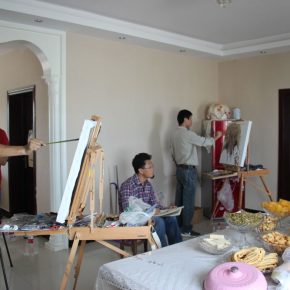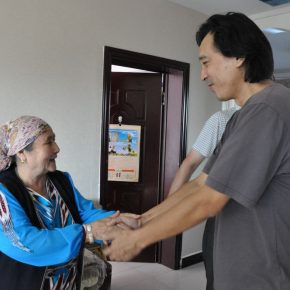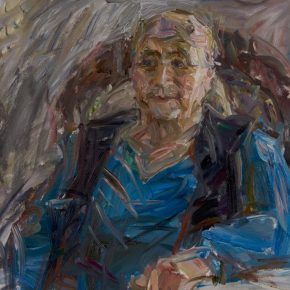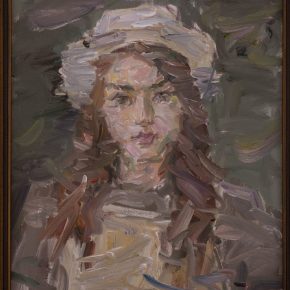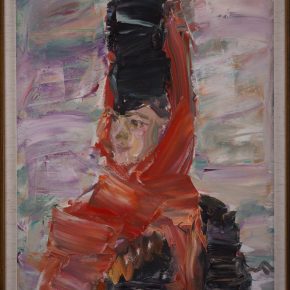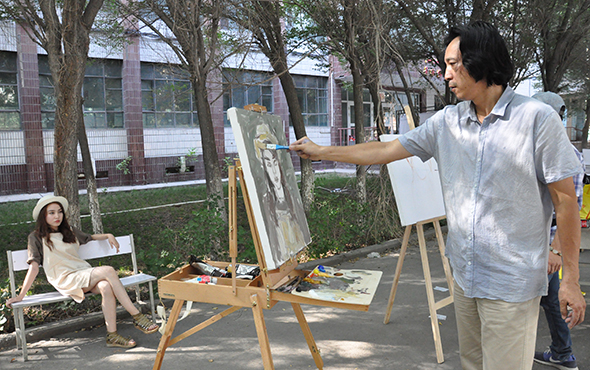
The large-scale exhibition of “Echo of Civilization • Portraits of the Times” officially opened in the Imperial Ancestral Temple in mid-January, 2018, featuring more than 300 artworks of different forms. In the part of “Ordinary Life”, it showcases the confident and graceful appearance of contemporary model workers in China. It presents “The Model Worker Alipa Alimahong from Xinjiang” which was created by Ma Gang, Director of the Thematic Arts Creation and Research Center in China and an artist, who shared his experience of leading a team to Xinjiang to draw a portrait of a model worker and the thoughts on the issues of portraits and thematic creation, when he was interviewed by CAFA ART INFO, he elaborated his ideas on contemporary art and current topics, the similarities and differences of the ways of portrayal between the East and the West.
Interview Time: January 28, 2018
Venue: Central Academy of Fine Arts
Interviewer and copywriter: Zhang Yizhi from CAFA ART INFO
Interviewee: Ma Gang
Translated by Chen Peihua and edited by Sue/CAFA ART INFO
CAFA ART INFO: The thematic creation of “portrait” has always been the major subject of artistic expression, from the ancient tomb murals, monarchs and meritorious statesmen, religious support, literati and admirable people, to the present diversified creations of figure paintings, “portraits” carry a moral etiquette, aesthetic orientation, cultural representation and social theme of the historical era, viewing a creation of portraits, it does not only recognize a specific character, but also understands the spirit of the times and the space in which the characters live. The portrait is like a mirror of the spirit of the times. So, if we start from the perspective of artistic creation, how do we understand the “times” of the “portraits of the times”, how do us grasp the contemporary?Ma Gang: Portraits appeared very early, but there were only a few works in the beginning and the true portraits in China appeared in the Ming Dynasty, while there were a large number of western portraits that appeared during the Renaissance, and it was the beginning of the portrait that became a single style of painting, and an independent art form. Portraits are closely linked with the times. For example, the king should have a portrait of himself to commemorate his reign, and some prominent celebrities must leave a portrait for future generations. These have become important visual images in history, so that there is a strong historical content and value. Because of the characteristic of portraits, we tend to create from this perspective when we draw portraits. Portraits represent people and people offer an integration of social relations, so that portraits are the easiest way to convey the characteristics of the times.
The previous portraits portrayed kings and nobility, religious leaders and wealthy people. However, in the 18th century and 19th century, when portraits arrived in Russia, the artists began to pay attention to ordinary people and people of all walks of life, so a vision of portraits was widened. The appearance of Russian portraits can be regarded as a development of western portraits. They focuses on the details and circumstances which are inevitably connected with real life. It has greatly improved the portrayal of the social characteristics of the characters, the portrayal of the individual personality & features, and the portrayal of the heart of the characters, so that the performance of the thematic content, art language and expression has been enriched. People can feel society and the story hidden in a portrait, so it shows a stronger sense of the times, a work is actually a novel.
CAFA ART INFO: According to your description of the tradition and evolving background of Western portraits, would you like to talk about the similarities and differences of Chinese portraits, and how to better understand their respective features and the reasons for the formation of such features?Ma Gang: Our traditional portraits actually portray figures which is different from the Western modeling system, the majority of the portraits handed down in China are anonymous, while painters signed and sealed the landscape, flower and bird paintings in China. Portraits of figures usually enjoy a frontal view instead of a lateral view. Different from Western portraits, it is a multi-perspective portrayal, and mainly focuses on the frontal view. Many families in China maintain the portraits of the family ancestors, old ladies and old men, and it is a way of preserving ancestral faces. There are some outstanding portraits of the Ming and Qing Dynasties and basically they depict frontal views. These portraits have also plentifully depicted the psychological portrayal. They have studied the anatomy of characters, which is used to portray characters. The Western portraits are an important part of the mainstream art in the West, so they have had attention and been developed, as well as explored in many aspects. In the past, the main responsibility of portraits lay in the recording of characters, but after the advent of photography, there have been some changes in the connotation of portraits.
CAFA ART INFO: As you mentioned, the functions of many art forms have changed with the advent of photography. The function of portraits at present is different from previously and would you like to tell us about the status quo of portraits? How do you regard these changes?Ma Gang: After the advent of photography, portraits have indeed been hit, but I think the impact has been weakened now. In fact, photography has also suffered a certain amount of impact, especially a large number of pictures that fill of our lives and photography is cheap with the advent of digital photography. People begin to pay attention to the model of “creating by hand”. The contemporary technology and tools make people hope for a return to nature, that is to say, people feel that the things related to men, directly created by men are still the most precious, and human beings return to the beginning after decades of rapid and lively changes. Human feelings and human emotions that are directly revealed are the most important thing. Producing works by hand is a method that carries more content. More and more people use oil painting or other tools to draw portraits and they have become regarded as precious and valuable so need to be collected.
CAFA ART INFO: What is the relationship between the sketch and thematic creation? What is the difference between the two? Please share it with us based on your sketching.Ma Gang: In my case, I generally emphasize the personal experience of sketching, especially in the process of connecting the heart with the hands and eyes. When I draw a portrait, I attempt to understand the objects and a sense of presence. On the one hand, I try my best to honestly draw a portrait, presenting the fresh, vivid, first sense of feeling. On the other hand, I hope everyone can feel the moment of presence from the screen. This feeling is like catching a fish, which will hurt you at the moment when you can’t catch it. It is unpredictable, but it is touching, so I especially enjoy life like painting, because it is the best way to find a feeling. The portrait creation is more complicated. It is necessary for portraits to have thematic content, ideas and a specified composition with a vivid expression of the image of the character, rather than simple vivid expressions of direct feelings from the scene. It captures vivid images through sketching and incorporates them into the creative thinking.
Take “The Model Worker Alipa Alimahong from Xinjiang” on show at the exhibition as an example, it is a portrait of a model worker from Xinjiang. Our team went to her home to create a life like painting, and we drew the subject as fast as possible for she was too old to sit for a long time, while this created a tension and pressure in the painting, which is a rare thing and precious part of the painting. From 2015 to 2016, the Propaganda Department in Xinjiang arranged the project for the creation for model workers from Xinjiang, and I led my team to create portraits of many model workers. At the same time I was also concerned with ordinary people, for example, I once saw a young man wearing a security uniform, with a nice facial expression when I was at the school gate, and I then immediately arranged the easel and drew a portrait, after I finished it, the gathered audience informed me that I had spent 28 minutes on it and it was a realistic painting experience for me.
CAFA ART INFO: For the portrayal of historical figures, the images of these characters that have been constructed in social, historical or cultural activities, have formed a definite cognition of image in the audience’s mind. What is the relationship between artistic creation and this existing image? How do we cater for it? Break through it? Rebuild it? Please combine your creation to talk about this.
Ma Gang: I think the personal cognition is of paramount importance, even in the creation of paintings related to historical figures. It is necessary to find our own cognition of the character, especially the people that we all know, we must find our own perception, or we can’t draw. In fact, the painting is linked to the self, which is the essential thing. It also works in the portraits. You might see some things from a person at a moment in time, so you choose him instead of others. Even if he is an ancient person, it must be something that connects him to you, including your own shadow, and I have been pondering this, it becomes very important. Even if it is a national creative project, the creation is of a project-based requirement, and we can also incorporate the connection in it. For important people, I choose a certain perspective of his image, a moment, which is actually based on our awareness of the character and the choice after the association appears.
CAFA ART INFO: Has the portrait creation always been the focus of your creation? Who greatly influenced your creations when you went to school before teaching in the school?Ma Gang: We never gave up drawing portraits. When we went to school, we drew portraits after drawing plaster figures. We sketched portraits as drawings and oil paintings, both drawing half-length and full-length portraits. At the beginning, I thought the figure sketching and portraits sketched in oil paint at that time were not efficiently drawn, but now it seems quite vivid, because they have captured the feeling at that time although they were not fully complete.
Mr. Jin Shangyi has heavily influenced me. I copied his paintings from studying painting in childhood, and he is my PhD supervisor. Mr. Jin has good health. Although he was not young any more, he still has a special feeling when he does life like painting. He is very good at catching the subject during his sketching and so is skillfully shaped. I used to emphasize sensual things, which is easy to discreetly draw the subject, and now I can basically “capture” the figure following the guidance of Mr. Jin.
CAFA ART INFO: The exhibition has also triggered a lot of discussion and some people think that “the narrative and creative paintings of prominent thematic features, fail to focus on depicting an individual so it can’t be strictly counted as a portrait”, how do you understand this issue? Has the significance of portrait creation changed today?Ma Gang: Because it is a portrait creation, it still has a border. I remember that there is a special gallery of portraits located at the National Portrait Gallery in London and it is a dedicated portrait gallery which has a clear definition of portraits. Although there are a variety of expressions, it is still a basic distinction based on social cognition. Portrait painting does not mean that it refuses a plot or a theme, but it needs to use portraits to reflect these things.
Portrait creation is still very meaningful today. The perspectives and expressions will change with the times, but it still focuses on people, as long as people exist, there will be portraits.



